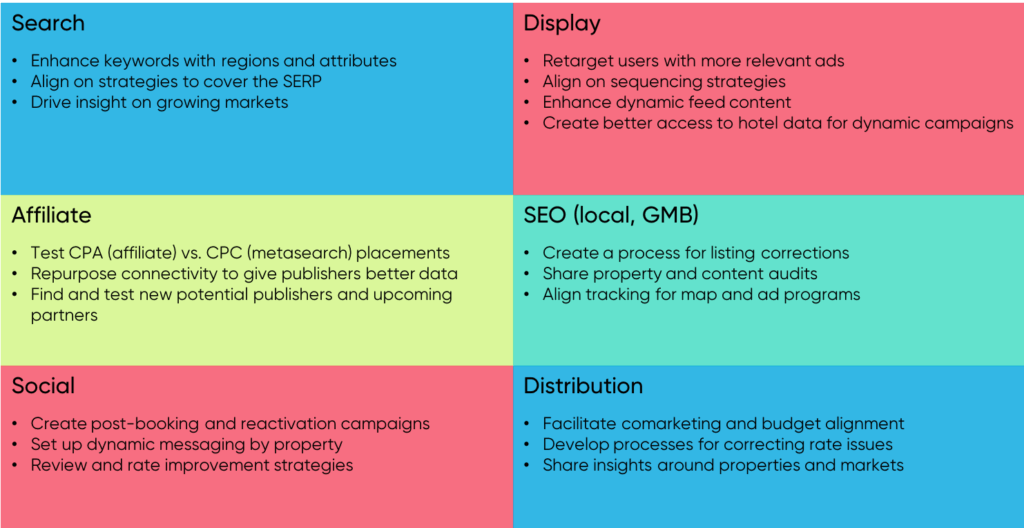
When we started, there was still a lot of mystery in the world of metasearch. There were probably less than 50 true experts in the entire world.
NB: This is an article from Koddi
Few people had real insight into how these campaigns worked across the market. When telling the story of our business, we’ll often share how, in our early days, we had to beg potential customers to focus more on the metasearch channel.
And so it went for years that metasearch was the younger, smaller sibling in the digital family. However, over the past 24 months, we’ve seen metasearch grow into a key channel, often the largest in terms of driving incremental revenue to the brands with whom we partner.
The Director of Metasearch
Even at this level of impact, metasearch is often the least understood channel in a digital portfolio. It is common for big advertisers to have Directors of SEM, SEO, Display, Social, Analytics, and so on, but we rarely see Directors or Sr. Managers of Metasearch.
Metasearch requires knowledge across the digital spectrum in order to maximize success:
- SEM: granular bidding, budgeting, and optimization
- SEO: user search paths, queries, and local
- Display: how and where content is displayed
- Social: audiences and user behavior
- Analytics: performance and insights
Going a level deeper, we see incredible results from teams that also have technical and distribution experience. Individuals and teams with experience across the spectrum move faster and drive more volume and return.
This is a lot of knowledge to collect and conquer. Internally, we remind our team that this is where all digital marketing is going in the future. Metasearch requires thinking for scale and automation across disciplines today, making it a great training ground for tomorrow’s digital leadership.
The Digital Travel Curriculum
To be great, the new class of digital leaders – in metasearch and beyond – needs to hone a set of skills across disciplines. However, expertise in everything isn’t required. Being an expert in a handful of focus areas is more than enough with the right foundation of general knowledge.
Knowing the Business
Having a true understanding of the business allows you to develop better instincts about the campaigns being run and what is driving changes in a campaign. There are three perspectives we like to think about:
1) The traveler. Spending time understanding how the traveler thinks, researches, purchases, and experiences gives you the ability to see trends others may not. What are they doing when they find your site? What information do they need to purchase? Will it be on visit one, ten, or thirty? Why?
2) The hotel. It is impossible to truly know the market without spending time around hotels. It can be helpful to do this not only as a guest but also as staff. The staff at hotels know more about their business and their guests than the hidden-away marketer ever can hope to know. It’s important to understand what Revenue Managers or Directors of Sales do and why they make the decisions they make.
3) The market. The market has a perspective on what’s going on at any given time and often can give incredible depth and context to performance. The market understands seasonal trends and knows what’s going on with pricing. It sees spikes and dips, as well as demand and reasons for it. The market perspective can be that of a few hotels in an area, of an entire region, or both.
In many cases, it isn’t possible to synthesize all of this information at once. Specialized experience and knowledge create intuition that is helpful, not only in analysis but also in day to day communication.
Technical Inclinations
We require everyone on our team to go through a little bit of technical training, even if their job isn’t technical. So many of the digital conversations of the future will have a technical angle. Equipped with a comfortable working knowledge of technology, our employees can speed through issues that would otherwise require additional resources.
Even a little knowledge can go a long way, and it’s most important to understand:
- How data flows from one area to another
- How sites serve content and URLs operate
- How to extract valuable data from analytics platforms
- What information is tracked when a user clicks
- Where certain key data comes from
- How connectivity works
- How to track down prices and availability
- What data feeds are required and why
- How, when, and where data gets updated
- Why an ad unit or experience is triggered
- What can’t we answer today and why
Accessing, extracting, and analyzing data are all important technical skills that empower digital leaders. Getting to the answer fast can be the difference between maximizing an opportunity or missing out. Three courses that will propel digital leaders are:
- Introduction to SQL: This course teaches how data is stored and structured, which gives helpful context when it comes to pulling data out of systems and insights out of data.
- Introduction to Statistics: Not every situation calls for a thorough analysis to determine the mean square error of a result. Using math can help make better decisions faster or model out different scenarios. Digital marketing is big – thousands of hotels, millions of keywords, billions of impressions – so successful marketers increasingly rely on models and improve those models instead of constantly chasing one-offs.
- Introduction to Agile or Project Management: At some point, even if they are not in a technical role, marketers will very likely have to engage with more technical resources or teams. We see many digital marketers unfamiliar with how these teams work. These introductions can help better navigate projects by providing insight into the communication and management approaches often employed by technical teams.
Competitive Intelligence
One of the often untapped benefits of participating in metasearch channels is the level of competitive intelligence it generates for advertisers. The most sophisticated and successful advertisers in the world mine this data and leverage it to improve their business by enhancing connectivity, customizing engaging user experiences, improving rates and distribution, and providing near real-time market intelligence to their teams.
In other digital channels, you might be able to use different tools to be able to see who is bidding on a keyword or going after a similar audience. In metasearch, you can understand down to an impression level what other rates are in the market and from where they originate.
Cross-Channel Strategy
Because metasearch sits at the intersection of so many different channels, it has the ability to positively impact and influence all them. Look for some of the opportunities below to maximize results across the digital portfolio:

We believe that metasearch will continue to thrive due to the level of utility it provides both users and advertisers. It will also continue to evolve, growing beside and with other digital channels. As the lines between channels blur, and advertisers focus more on the user and the action than the medium, the skills that make for an impressive metasearch leader today will be the foundation for the world’s most successful marketers tomorrow.




